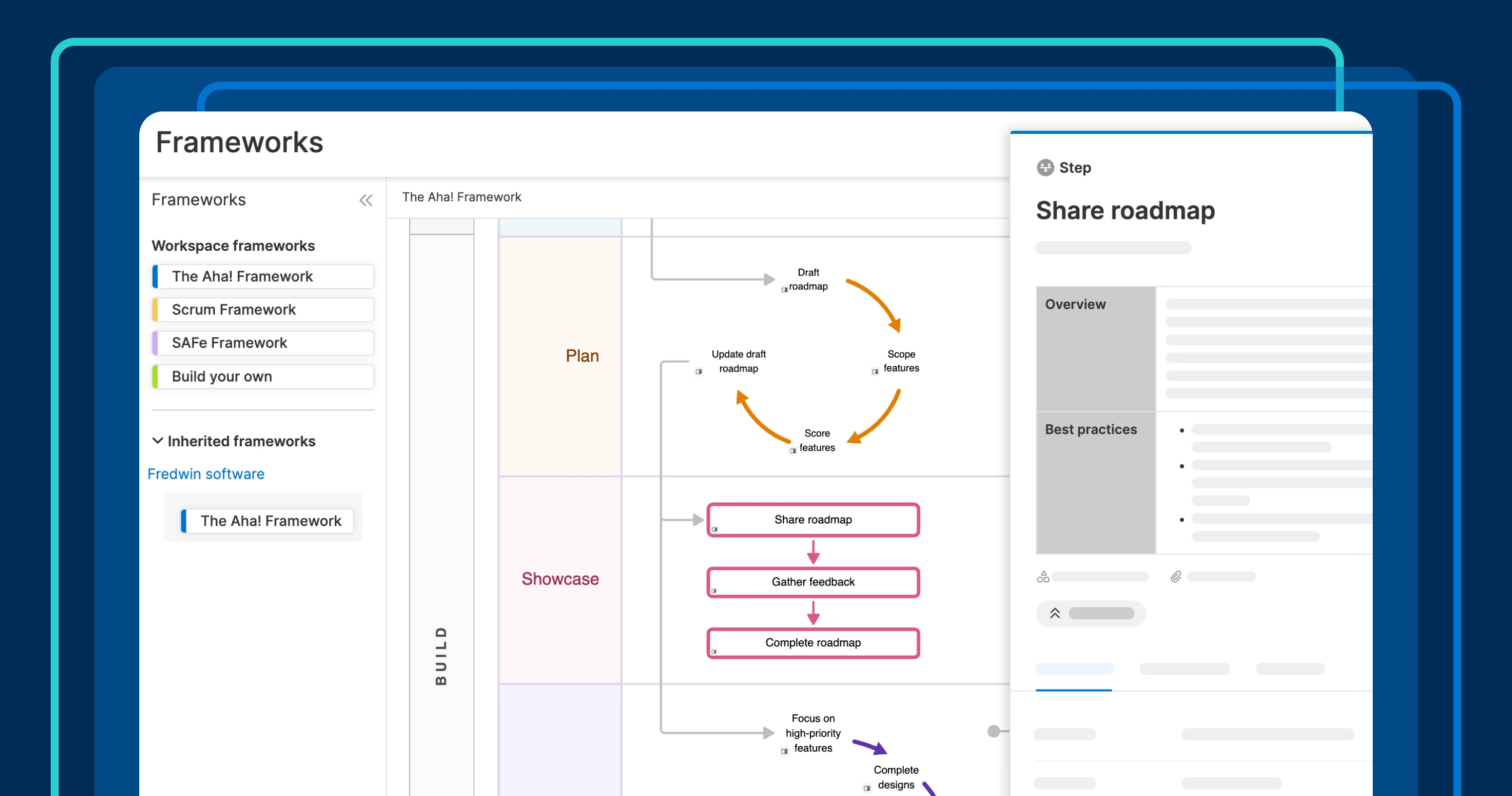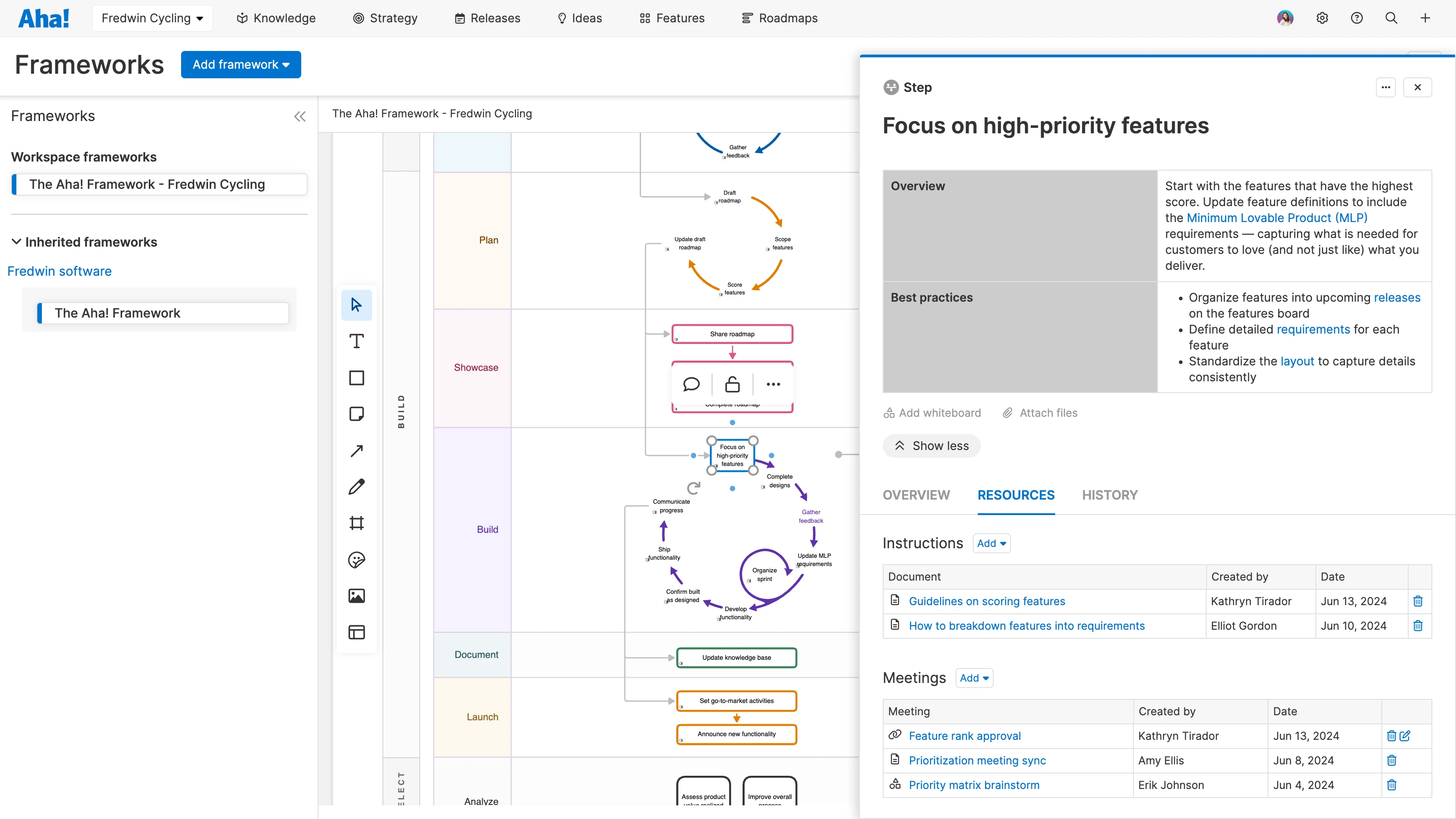
The Aha! Framework for product development in Aha! Roadmaps
Introducing Frameworks — a new way to define your product development methodology
An agreed-upon product development framework is essential for team success. But even if you try to standardize how you build software, it is incredibly challenging to get teams aligned. You might have an idea of how you should work, but that does not mean it lines up with how you do work. Procedures and best practices might be poorly defined or end up scattered across tools and teams. If people cannot find them, they will not follow them. There has to be a better way.
Today, we are introducing Frameworks: a breakthrough way to define and diagram how the team works in the same tool where you actually work.
You will see a new area of functionality in the Knowledge section of Aha! Roadmaps called Frameworks. This is a dedicated space for documenting your organization's product development methodology. You can map out stages in your process — from setting strategy and capturing feedback to building and launching new experiences for customers (and beyond). Then, you can link out to other areas in Aha! software so the team has quick access to foundational documentation and necessary context.
No matter where you are in your product development process's maturity, you can make use of this new functionality. For instance:
If you follow a common methodology such as scrum or Scaled Agile Framework®: You will find templates within the Frameworks section for these methodologies. These templates come with defined activities and detailed best practices.
If you take an agile, hybrid, or tailor-made approach: You can build your diagram from scratch to include the stages, steps, and details you need.
If you want to work like we do: Choose The Aha! Framework. This template shares our strategic approach to agile work, which you can use as a blueprint for your own success.
To get started, click Add framework and select a template or build your own. Each template comes with a pre-defined diagram that includes steps and best practices. Each one has the same dynamic features as a whiteboard — with the added ability to convert objects into steps in your process.
Converting an object into a step allows you to add more details (or metadata) about this part of your process. For example, summarize the work and include links to other resources. Add information about the step's duration, frequency, and key stakeholders. This way, the team can click the step and see exactly what it entails.
This new functionality is available to all Aha! Roadmaps customers starting today. You can create frameworks at any level of your workspace hierarchy and add as many as you need. We suggest creating your first framework at the company line so other workspaces can inherit the framework as a starting point and then copy it to customize it further.
Get started now:
Select a pre-created framework
Document how the team should work across the entire product development lifecycle. In the example below, we define how the fictitious Fredwin organization builds products. Selecting The Aha! Framework template gives us a head start and adds shape to some of the phases where we could use more structure. Fredwin is a multiproduct company, so it is helpful that The Aha! Framework defines how to coordinate strategic planning and development across a product portfolio.
Make it your own
Next, we want product teams to customize the framework as needed. The Fredwin Cycling team adds more information to the first step of the build phase — detailed instructions and relevant meeting notes will come in handy. We also link to the team's prioritization view: a ranked list of upcoming features that folks will work on. Everything is now within reach. Teammates understand agreed-upon processes to follow and can get back to work.
Embrace the framework to see success
With a new framework defined and diagrammed, we feel confident that how we plan to work will align with how we will work. The details and references in each step clarify what happens and when. And we can refer to them without switching tools or losing track of work that is in progress.
Consistency across teams allows you to move faster and deliver more value.
We are here to help you succeed. Let us know if you need help standardizing your own approach and aligning the organization. And check out our brand-new guide that details each aspect of the Aha! product development process, including how we do both strategic planning and agile development simultaneously. You can also join us for a live tutorial on July 25 that will cover how we build software in addition to how to build and adopt your own framework.
Start a free trial of Aha! Roadmaps
Aha! Roadmaps is the best way to set strategy, prioritize features, and share visual plans. It also includes everything in Aha! Ideas Essentials, Aha! Whiteboards Essentials, and Aha! Knowledge Essentials to provide a complete product management solution. Sign up for a free 30-day trial or join a live demo to see why more than 1 million product builders trust our software to build lovable products and be happy doing it.





